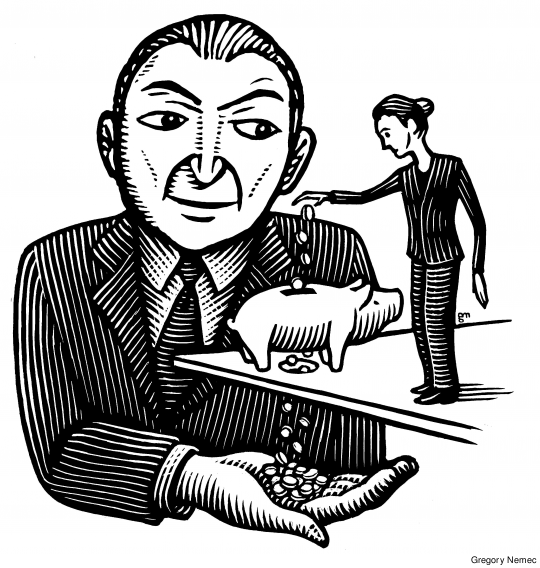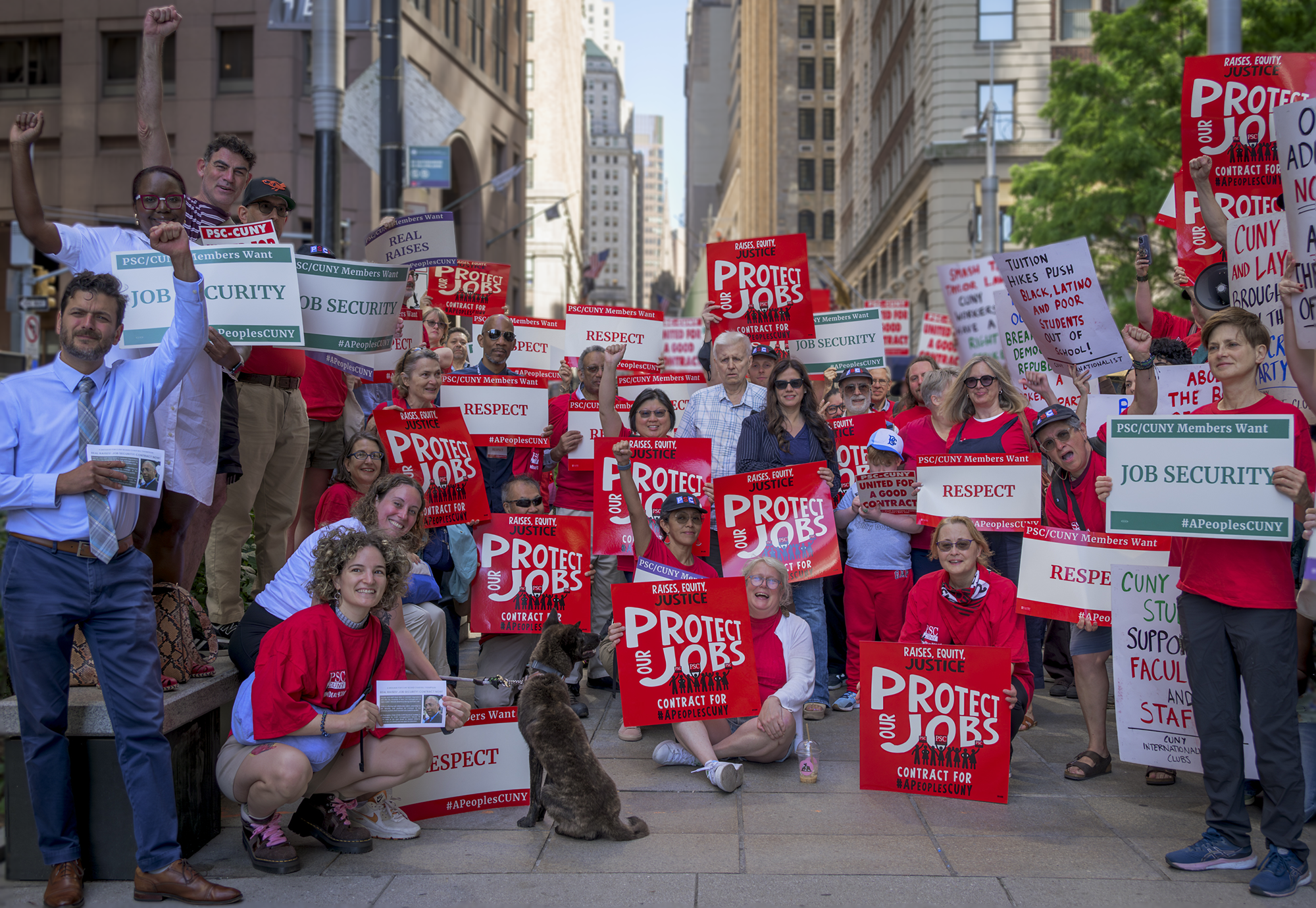
Editor’s note: In New York state, anti-union pundits and politicians are demanding pension cuts for new public employees. They argue that private-sector workers don’t have pensions this good, so in fairness, public-sector benefits must come down to the private-sector level.
But as former Wall Street Journal reporter Ellen Schultz details below, the erosion of private-sector pensions didn’t “just happen.” It is the result of a deliberate transfer of wealth from workers to corporate executives and shareholders – a “pension heist,” to borrow the title of Schultz’s new book. The excerpt below summarizes her conclusions and details the recent case of General Electric; the book is filled with detailed accounts of similar maneuvers by other corporations.
The same corporate interests that attacked private-sector pensions yesterday are leading the charge to slash public-sector pensions today. For example, General Electric’s GE Asset Management is part of the Partnership for New York City, a corporate lobbying group that is one of the loudest voices calling for cuts in the pensions of public workers (see Clarion, April 2011).
Meanwhile, GE’s top executives have seen their pensions grow richer than ever.
In December 2010, General Electric held its Annual Outlook Investor Meeting at Rockefeller Center in New York City. At the meeting, chief executive Jeffrey Immelt stood on the Saturday Night Live stage and gave the gathered analysts and shareholders a rundown on the global conglomerate’s health. But in contrast to the iconic comedy show that is filmed at Rock Center each week, Immelt’s tone was solemn. Like many other CEOs at large companies, Immelt pointed out that his firm’s pension plan was an ongoing problem. The “pension has been a drag for a decade,” he said, and it would cause the company to lose 13 cents per share the next year. Regretfully, to rein in costs, GE was going to close the pension plan to new employees.
The audience had every reason to believe him. An escalating chorus of bloggers, pundits, talk show hosts, and media stories bemoan the burgeoning pension-and-retirement crisis in America, and GE was just the latest of hundreds of companies, from IBM to Verizon, that have slashed pensions and medical benefits for millions of retirees. To justify these cuts, companies complain they’re victims of a “perfect storm” of uncontrollable economic forces – an aging workforce, entitled retirees, a stock market debacle, and an outmoded pension system that cripples their chances of competing against pensionless competitors and companies overseas.
What Immelt didn’t mention was that, far from being a burden, GE’s pension and retiree plans had contributed billions of dollars to the company’s bottom line over the past decade and a half, and were responsible for a chunk of the earnings that the executives had taken credit for. Nor were these retirement programs – even with GE’s 230,000 retirees – bleeding the company of cash. In fact, GE hadn’t contributed a cent to the workers’ pension plans since 1987 but still had enough money to cover all the current and future retirees.
And yet, despite all this, Immelt’s assessment wasn’t entirely inaccurate. The company did indeed have another pension plan that really was a burden: the one for GE executives. And unlike the pension plans for a quarter of a million workers and retirees, the executive pensions, with a $4.4 billion obligation, have always been a drag on earnings and have always drained cash from company coffers: more than $573 million over the past three years alone.
So a question remains: With its fully funded pension plan, why was GE closing its pensions?
A look at what really happened to GE’s pensions illustrates some of the reasons behind the steady erosion of retirement benefits for millions of Americans at thousands of companies.
RETIREE PENSIONS UNFAIRLY BLAMED
No one disputes that there’s a retirement crisis, but the crisis was no demographic accident. It was manufactured by an alliance of two groups: top executives and their facilitators in the retirement industry – benefits consultants, insurance companies, and banks – all of whom played a huge and hidden role in the death spiral of American pensions and benefits.
Yet, unlike the banking industry, which was rightly blamed for the subprime mortgage crisis, the masterminds responsible for the retirement crisis have walked away blame-free. And, unlike the pension raiders of the 1980s, who killed pensions to extract the surplus assets, they face no censure. If anything they are viewed as beleaguered captains valiantly trying to keep their overloaded ships from being sunk in a perfect storm. In reality, they’re the silent pirates who looted the ships and left them to sink, along with the retirees, as they sailed away safely in their lifeboats.
The roots of this crisis took hold two decades ago, when corporate pension plans, by and large, were well funded, thanks in large part to rules enacted in the 1970s that required employers to fund the plans adequately and laws adopted in the 1980s that made it tougher for companies to raid the plans or use the assets for their own benefit. Thanks to these rules, and to the long-running bull market that pumped up assets, by the end of the 1990s pension plans at many large companies had such massive surpluses that the companies could have fully paid their current and future retirees’ pensions, even if all of them lived to be 99 and the companies never contributed another dime.
But despite the rules protecting pension funds, US companies siphoned billions of dollars in assets from their pension plans. Many, like Verizon, used the assets to finance downsizings, offering departing employees additional pension payouts in lieu of cash severance. Others, like GE, sold pension surpluses in restructuring deals, indirectly converting pension assets into cash.
To replenish the surplus assets in their pension piggy banks, companies cut benefits. Initially, employees didn’t question why companies with multibillion-dollar pension surpluses were cutting pensions that weren’t costing them anything, because no one noticed their pensions were being cut. Employers used actuarial sleight of hand to disguise the cuts, typically by changing the traditional pensions to seemingly simple “cash balance” pension plans, which superficially resembled 401(k)s.
Cutting benefits provided a secondary windfall: It boosted earnings, thanks to new accounting rules that required employers to put their pension obligations on their books. Cutting pensions reduced the obligations, which generated gains that are added to income. These accounting rules are the Rosetta Stone that explains why companies with massively overfunded pension plans went on a pension-cutting spree and began slashing retiree health benefits even when their costs were falling. By giving companies an incentive to reduce the liability on their books, the accounting rules turned retiree benefits plans into cookie jars of potential earnings enhancements and provided employers with the means to convert the trillion dollars in pensions and retiree benefits into an immediate, dollar-for-dollar benefit for the company.
EXEC PAY THRIVES
With perfectly legal loopholes that enabled companies to tap pension plans like piggy banks, and accounting rules that rewarded employers for cutting benefits, retiree benefits plans soon morphed into profit centers, and populations of retirees essentially became portfolios of assets and debts, which passed from company to company in swirls of mergers, spin-offs and acquisitions. And with each of these restructuring deals, the subsequent owner aimed to squeeze a profit from the portfolio, always at the expense of the retirees.
The flexibility in the accounting rules, which gave employers enormous latitude to raise or lower their obligations by billions of dollars, also turned retiree plans into handy earnings-management tools.
Unfortunately for employees and retirees, these newfound tricks coincided with the trend of tying executive pay to performance. Thus, deliberately or not, the executives who green-lighted massive retiree cuts were indirectly boosting their own pay.
As their pay grew, managers and officers began diverting growing amounts into deferred-compensation plans, which are unfunded and therefore create a liability. Meanwhile, their supplemental executive pensions, which are based on pay, ballooned along with their compensation. Today, it’s common for a large company to owe its executives several billion dollars in pensions and deferred compensation.
These growing “executive legacy liabilities” are included in the pension obligations employers report to shareholders, and account for many of the “growing pension costs” companies are complaining about. Unlike regular pensions, the growing executive liabilities are largely hidden, buried within the figures for regular pensions. So even as employers bemoaned their pension burdens, the executive pensions and deferred comp were becoming in some companies a bigger drag on profits.
WORKERS CONTINUE TO LOSE
With the help of well-connected Washington lobbyists and leading law firms, over the past two decades employers have steadily used legislation and the courts to undermine protections under federal law, making it almost impossible for employees and retirees to challenge their employers’ maneuvers. With no punitive damages under pension law, employers face little risk when they unilaterally slash benefits, even when promised in writing, since they can pay their lawyers with pension assets and drag out the cases until the retirees give up or die.
As employers curtail traditional pensions, employees are increasingly relying on 401(k) plans, which have already proven to be a failure. Employees save too little, too late, spend the money before retiring, and can see their savings erased when the market nosedives.
Today, pension plans are collectively underfunded, hundreds are frozen, and retiree health benefits are an endangered species. And as executive pay and executive pensions spiral, these executive liabilities are slowly replacing pension obligations on many corporate balance sheets.
Meanwhile, the same crowd that created this mess – employers, consultants, and financial firms – are now the primary architects of the “reforms” that will supposedly clean it up. Under the guise of improving retirement security, their “solutions” will enable employers to continue to manipulate retirement plans to generate profit and enrich executives at the expense of employees and retirees. Shareholders pay a price, too.
Their tactics haven’t served as case studies at Harvard Business School, and aren’t mentioned in the copious surveys and studies consultants produce for a gullible public. But the masterminds of this heist should take a bow: They managed to take hundreds of billions of dollars in retirement benefits that were intended for millions of workers and divert them to corporate coffers, shareholders, and their own pockets. And they’re still at it.
______________________________
A former investigative reporter for The Wall Street Journal, Ellen Schultz covered the so-called retirement crisis for the Journal for more than a decade. Adapted from Retirement Heist by Ellen Schultz, by arrangement with Portfolio, a member of Penguin Group (USA), Inc., Copyright © Ellen Schultz 2011.

